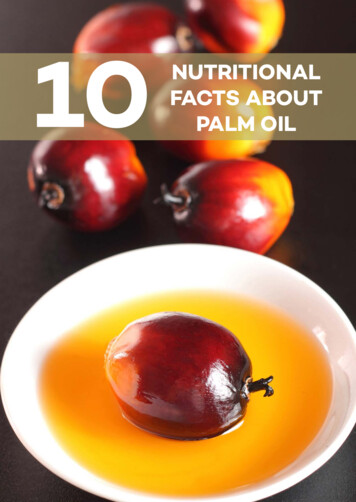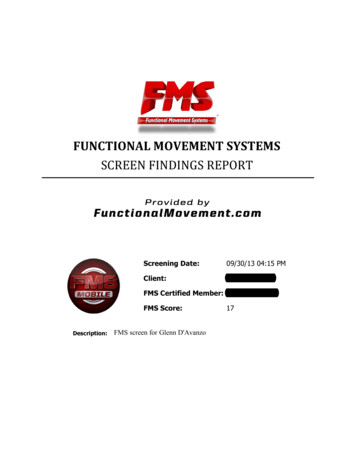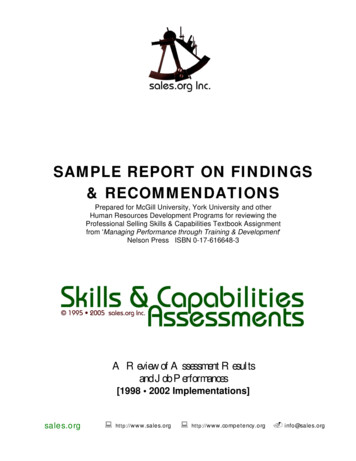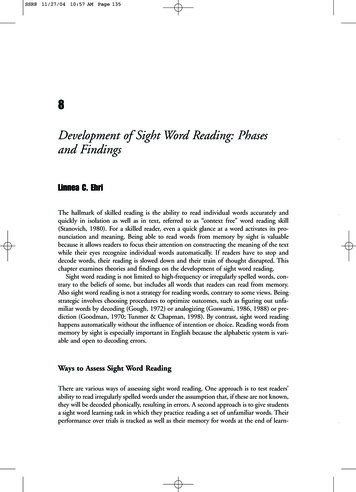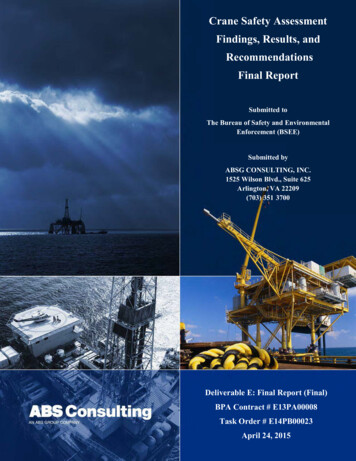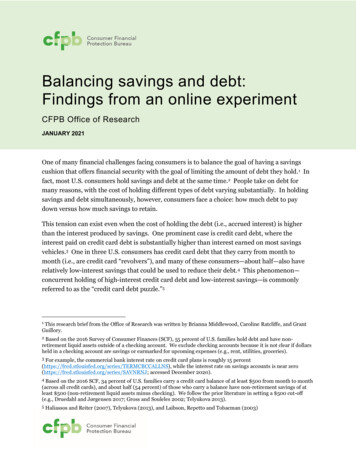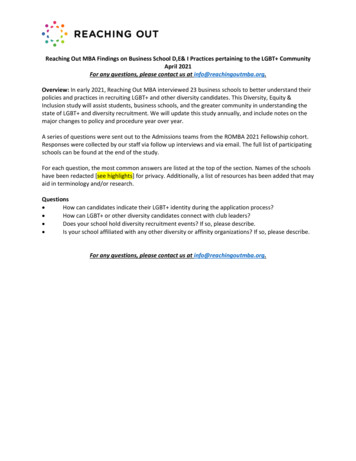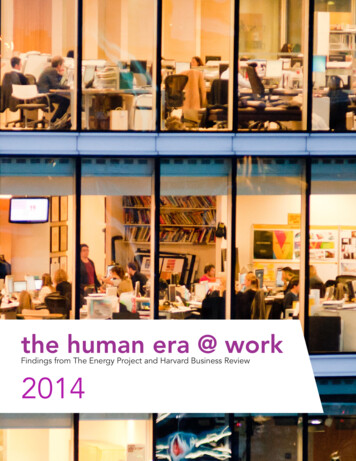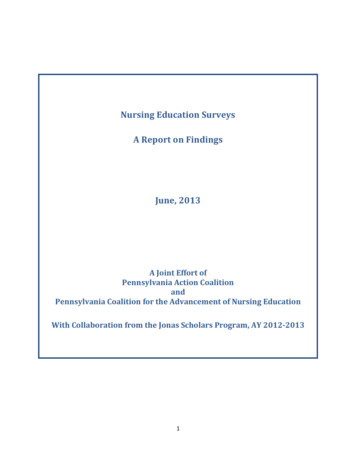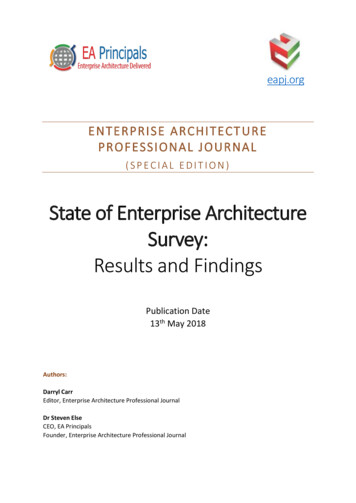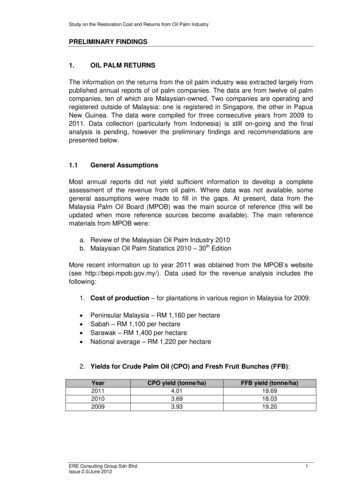
Transcription
Study on the Restoration Cost and Returns from Oil Palm IndustryPRELIMINARY FINDINGS1.OIL PALM RETURNSThe information on the returns from the oil palm industry was extracted largely frompublished annual reports of oil palm companies. The data are from twelve oil palmcompanies, ten of which are Malaysian-owned. Two companies are operating andregistered outside of Malaysia: one is registered in Singapore, the other in PapuaNew Guinea. The data were compiled for three consecutive years from 2009 to2011. Data collection (particularly from Indonesia) is still on-going and the finalanalysis is pending, however the preliminary findings and recommendations arepresented below.1.1General AssumptionsMost annual reports did not yield sufficient information to develop a completeassessment of the revenue from oil palm. Where data was not available, somegeneral assumptions were made to fill in the gaps. At present, data from theMalaysia Palm Oil Board (MPOB) was the main source of reference (this will beupdated when more reference sources become available). The main referencematerials from MPOB were:a. Review of the Malaysian Oil Palm Industry 2010b. Malaysian Oil Palm Statistics 2010 – 30th EditionMore recent information up to year 2011 was obtained from the MPOB’s website(see http://bepi.mpob.gov.my/). Data used for the revenue analysis includes thefollowing:1. Cost of production – for plantations in various region in Malaysia for 2009: Peninsular Malaysia – RM 1,160 per hectareSabah – RM 1,100 per hectareSarawak – RM 1,400 per hectareNational average – RM 1,220 per hectare2. Yields for Crude Palm Oil (CPO) and Fresh Fruit Bunches (FFB):Year201120102009ERE Consulting Group Sdn BhdIssue 2.0/June 2012CPO yield (tonne/ha)4.013.693.93FFB yield (tonne/ha)19.6918.0319.201
Study on the Restoration Cost and Returns from Oil Palm IndustryPRELIMINARY FINDINGS3. Sales price of CPO and FFB:Year201020091.2CPO (RM/tonne)2,704.502,244.50FFB (RM/tonne)587481Highlights of Data CollectedFor the purpose of calculating the revenue from oil palm companies, data extractedfrom the annual reports are focused on (1) yield, (2) cost of production and (3)average sales price for FFB and CPO. Data from FFB production only takes intoaccount FFB that was harvested by the company’s own estates and does notinclude smallholders (also known as plasma collection of FFB in Indonesia). All companies except one reported their total FFB production for thefinancial year. Data for FFB yield per hectare were reported by all the companies in thesample, but data for CPO yield per hectare was only reported by sixcompanies. The range of FFB yields for 2011 was between 16.5 tonne per hectare and25.16 tonne per hectare. The national average for Malaysia for FFB yieldaccording to MPOB was 19.69 tonne per hectare. The range of CPO yield was between 3.90 tonne per hectare and 5.47tonne per hectare in year 2011. The national average for Malaysia for CPOyield according to MPOB was 4.01 tonne per hectare. Information on oil yield was focused on CPO yield only. It was from elevencompanies. One company reported its combined yield of CPO and PalmKernel and was therefore not used for analysis. Data for the cost of production were only reported by three oil palmcompanies. Production cost was divided into two main components i.e.estate cost and mill cost. Three oil palm companies provided partialproduction costs. Data on average sales price for CPO were indicated in all the annual reportsfor all three financial years whereas four companies stated the averagesales price for FFB out of the eleven companies analysed. Analysis on the rate of returns which uses MPOB’s average annual datamay not reflect the actual rate of returns from private companies. It isimportant to note that MPOB’s data covered the general oil palm industry inERE Consulting Group Sdn BhdIssue 2.0/June 20122
Study on the Restoration Cost and Returns from Oil Palm IndustryPRELIMINARY FINDINGSMalaysia which comprises of private estates, government schemes (e.g.FELDA, FELCRA), state schemes and smallholders.Summary of Preliminary Findings1.3 In 2011, the average FFB yield was 21.75 tonnes per hectare, ranging from16.5 tonnes to as high as 25.40 tonnes per hectare. The average FFB yieldsrecorded in 2010 were 21.09 tonnes whereas in 2009, average yieldsrecorded was at 22.44 tonnes. In 2011, the average CPO yield was 4.73 tonnes per hectare, ranging from3.90 tonnes to as high as 5.47 tonnes per hectare. The average CPO yieldsrecorded in 2010 were 4.66 tonnes whereas in 2009, average yieldsrecorded was at 5.12 tonnes. In 2011, the average total production cost per tonne of CPO was RM 1,011,ranging from as low as RM 807 to as high as RM 1,248 (MPOB reportedthat the average production cost per tonne of CPO was RM 1,220). In 2010,the average total production cost was RM 943 whereas in 2009, the averagetotal production cost was recorded at RM 938. The average price for CPO was RM 3,122 per tonne in 2011, ranging fromas low as RM 2,906 to as high as RM 3,379 per tonne. Lower prices wererecorded in 2010 and 2009, respectively at RM 2,566 and RM 2,225 pertonne. Based on the above (and where necessary using data from MPOB), theaverage rate of returns for in 2011 was estimated at RM 8,719 per hectare.The lowest rate of return was recorded at RM 7,020 and the highest wasrecorded at RM 12,269. In 2010, the average rate of returns was recorded at RM 6,010 per hectare,where the highest rate of return was recorded at RM 8,812 per hectare andthe lowest rate of return was recorded at RM 4,317.30 per hectare. In 2009, the average rate of returns was recorded at RM 4,986 per hectare,where the highest rate of return was recorded at RM 9,988 per hectare andthe lowest rate of return was recorded at RM 3,261 per hectare. Overall, the rate of returns range from a low of RM 3,216 to a high of RM12,269 per hectare, generally reflecting variations in the average prices ofCPO.ERE Consulting Group Sdn BhdIssue 2.0/June 20123
Study on the Restoration Cost and Returns from Oil Palm IndustryPRELIMINARY FINDINGSChart 1: Rate of returns and CPO prices for Year 2011Chart 2: Rate of returns and CPO Price for Year 2010ERE Consulting Group Sdn BhdIssue 2.0/June 20124
Study on the Restoration Cost and Returns from Oil Palm IndustryPRELIMINARY FINDINGSChart 3: Rate of returns and CPO Price for Year 2009ERE Consulting Group Sdn BhdIssue 2.0/June 20125
Study on the Restoration Cost and Returns from Oil Palm IndustryPRELIMINARY FINDINGS2.RESTORATION COSTS2.1Costs for Reforestation/Forest Rehabilitation of Dipterocarp ForestsSix case studies pertaining to reforestation/rehabilitation of dipterocarp forests werereviewed, of which, three were research projects while the remaining three werereforestation projects. From the collected data on research projects, the costsranged from RM 380 to RM 11,688 per hectare. However, these projects differconsiderably in the activities that were carried out. Furthermore, comparativemeasures of the success of these projects (e.g. seedling survival rates) could notbe assessed.The lowest cost published from a research project was from an evaluation ofmethods for rehabilitation of logged-over dipterocarp forests in Pasoh, NegeriSembilan (Maswar et al., 1999), which was RM 380 per hectare for gap plantingmethod with an area of 10m x 10m x 5ha-1. Costs for three other methods used inthe study were RM 2,862 per hectare (line planting), RM 1,520 per hectare (gapplanting: 20m x 20m x 5ha-1) and RM 684 per hectare (gap planting: 10m x 10m x9ha-1) respectively. The costs for these methods covered site preparation, seedlingprocurement and planting activities. Another research, which was on the earlyestablishment of dipterocarp seedlings (Raja Barizan & Newbery, 2008) cost RM4,633 per hectare for an area of 5.6 hectare for four years (1991-1994). The costcovers aspects such as planting stocks, fertilizer, transportation, planting andmaintenance.A study on the rehabilitation of logged-over dipterocarp forest using an improvedplanting technique reported a cost of RM 11,688 per hectare for an area of 9.6hectares for a period of five years (1998-2003). The study plot established for thisproject was 32 hectare but the plantable area was confined only to open anddegraded sites which were about 30% of the area only. The high cost in this studywas due to methodology whereby planting was done using own-raised seedlingsand seedlings from a private nursery. The difference in cost between the twomethods was due to the price of the seedlings, whereby the cost for own-raisedseedlings was RM 4 per sapling versus RM 10 per plant from the private nursery.Cost per hectare from actual restoration projects ranged from RM 3,000 to RM8,000 per hectare. These figures are from Ulu Kalumpang Forest ReserveRestoration Project, Ulu-Segama Malua Sustainable Forest Management Projectand Malua Wildlife Conservation Bank project.The restoration cost for the Ulu Kalumpang Forest Reserve Restoration Project wasRM 3,297 per hectare for five years for 5,118 hectare of lowland dipterocarpforests. The cost covered activities like planting preparation (RM 1,233 perhectare), activity and materials cost (RM 1,584 per hectare) and maintenance andseedling replacement (RM 480 per hectare) (Sabah Forestry Department, 2012).ERE Consulting Group Sdn BhdIssue 2.0/June 20126
Study on the Restoration Cost and Returns from Oil Palm IndustryPRELIMINARY FINDINGSThe Ulu-Segama Malua Sustainable Forest Management Project restoration costwas RM 3,394 per hectare for five years for 241,098 hectare of lowland dipterocarpforests. The overall duration of this project is 10 years (2008-2017), whereby thefirst five years focuses on silvicultural treatment and reforestation of highlydegraded forests. The restoration cost mentioned earlier covers silviculturaltreatment (RM350 per hectare), planting preparations (RM506 per hectare ), activityand materials (RM1,038 per hectare ) and maintenance and materials (RM1,500per hectare ) (Sabah Forestry Department, 2012).For the Malua Wildlife Conservation Bank, restoration work has yet to be begin,however, New Forests has investigated costs for restoration work in Malua and therange is between RM 5,000 to RM 7,000 per hectare for three to five years ofrestoration activities like climber cutting, enrichment planting and maintenance ofhighly degraded forest. This cost however does not include long-term managementresponsibilities and operational commitment to conserve the areas so additionalcosts would need to be factored in (New Forests, 2012).2.2Costs for Restoration of Mangrove ForestsCosts of mangrove restoration were reported to range from USD 225 to 216,000per hectare (RM 707 to 679,115) according to Lewis (2001) in a review of costs andbenefits on mangrove restoration. The cost range however does not include thecost of any land purchase to provide a site for restoration. Higher costs are usuallyassociated with excavation of fill, or backfilling of an excavated area to achieve atarget restored site with the same general slope and tidal elevations relative to areference site.A case study presented by Lewis in the review was the conversion of abandonedshrimp aquaculture ponds back to their former condition as mangrove forests as anexample of hydrological restoration as a more cost-effective method. The cost torestore mangrove forests from the abandoned ponds is about USD 200 per hectare(RM 629 per hectare) using hydrological restoration or USD 700 per hectare(RM2,201 per hectare ) if using conventional planting methods.TEEB (2009) gave another estimate on the rehabilitation and restoration of ‘postshrimp-farming’ mangroves whereby the rehabilitation cost for the first year wasUSD 8,240 per hectare (RM 25,907 per hectare) followed by an annual cost of USD118 per hectare (RM 371 per hectare) for maintenance and protection of seedlings.For the Mangrove Restoration Project in Sabah, Malaysia, the restoration cost werebetween RM 5,000 to RM 8,000 per hectare for a period of five years (2006-2010)covering 735.86 hectares of mangrove forests. The initial allocated restoration costwas RM 5,000 per hectare but was increased to the aforementioned range intandem with the rising cost of goods and services (maintenance, petrol/diesel,workforce, etc.) in Sabah. The cost covers aspects such as replanting activitiesERE Consulting Group Sdn BhdIssue 2.0/June 20127
Study on the Restoration Cost and Returns from Oil Palm IndustryPRELIMINARY FINDINGS(survey works, boundary marking, establishment of mangrove nurseries, etc.), staffrecruitment and project supervision.The Zambales Mangrove Rehabilitation Program in Philippines had a restorationcost of Php 114,347 per hectare (RM 8,385 per hectare) for 402.65 hectares ofmangrove forests over a period of five years (2006-2011). The cost coveredaspects such as nursery operations (procurement of propagules and seedlings ofother species), establishment (site preparation, transportation and plantingpropagules/seedlings), maintenance and protection, infrastructure, information andeducation campaign, livelihood development and administration costs.2.3Costs for Restoration of Peat Swamp ForestsCost estimates from Global Environment Centre (2012) for converting palm oilplantations back into peat swamp forests was approximately RM 34,500 perhectare. Costs include: Removal of oil palm trees or land preparation: RM 3,000Labour costs of planting 400 tree saplings per hectare : RM 900Saplings cost: RM 10,000Ditch blocking: RM 6,500Post-planting maintenance of site for 2 years: RM 7,400Fire prevention: RM 2,200Management, admin cost, monitoring: RM 4,500Costing for each of the aspects above was: If land was cultivated with oil palm - Assuming one excavator for 2 days perhectare @ RM 1000/day including removal or shredding of removedmaterials plus RM 50 x 4 person per day for lining and marking of plantingsites with bamboo stake1If land was not covered with oil palm – R M50 x 4 person x 8 days for cuttingplanting lines; equipment rental and fuel plus 400 bamboo stakes, etc.Labour costs - RM50 x 4 person x 2 days; planting equipment rental andfertiliser (RM 500)Saplings cost – RM 25 x 400 trees/ hectareDitch blocking – RM 1000 for canal blocking materials (mangrove poles,sand bags and plastic sheet); Cost of labourers @ RM 50 x 10 peoplePost maintenance of site – RM 25 x 80 seedlings; fertilizer costs @ RM200/yr; weeding and fertilizer application RM 50/day x 4 person x 8 times/year x 2yrs1Note however that there could be arguments for leaving existing oil palms in place in some cases. This is due tothe spreading of the palms’ roots which may bind the soil if the trees are allowed to remain. Against this, the oilpalm is an exotic outside its native West Africa, so leaving it in place introduces a foreign element to regenerating“natural” forest.ERE Consulting Group Sdn BhdIssue 2.0/June 20128
Study on the Restoration Cost and Returns from Oil Palm IndustryPRELIMINARY FINDINGS Fire prevention: 300 person days/yr patrolling @ RM 60/day includingtransport; fire control costs of RM 4000/yr for 100 hectare x 10 yearsCost for research on rehabilitation of degraded peat swamp forest was RM13,224for 1.6 hectares for a period of eight months. Cost for techniques used in the studywas: 2.4Open planting: RM 2327Open planting mulching: RM 2787Open planting topsoil: RM 2903Open planting nurse trees: RM 5207Cost of Restoration in IndonesiaIn a progress report by Nawir et al. (2003) on a review of forest rehabilitationinitiatives in Indonesia, the Ministry of Forestry estimated that current rehabilitationstandard costs in Indonesia at the time was in the range of Rp 2.5 to Rp 5 millionper hectare (RM 821 to RM1,642). This cost range may well reach Rp 87.2 – 218trillion (RM 32 to RM 80 billion) with the increasing rate of degraded areas.In the same review, the average cost per hectare from 38 projects in the preliminarydatabase was from USD 43 to USD 15,221 (RM 135 to RM 48,247). The reviewalso compared restoration costs based on funding sources, whereby averagerestoration costs per hectare from government funding sources ranged from USD43 – USD 7,320 per hectare (RM 135 to RM 23,058 per hectare), USD 366 – USD15,221 per hectare (RM 1,153 to RM 47,946 per hectare) for restoration projectsreceiving funds from donors and USD 115 – USD 8,500 per hectare (RM 362 to RM26,775 per hectare) for private funding sources.Sutisna (1999) carried out an experiment to determine how the taungya systembenefits forest rehabilitation. The experiment covered an area of two hectare onlywith a total cost of Rp 10 million (RM 3,284 for two hectares; approximately RM1,642 per hectare). The cost covered aspects like: Layout for plot: Rp 40,000Bordering for 2 hectare plot: Rp 199,500Sub blocking: Rp 27,500Vegetation inventory: Rp 40,000Site preparation: Rp 1,947,450Collection of plant materials: Rp 1,676,600Planting: Rp 900,000Weeding: Rp 630,000Fertilizing: Rp 822,425Construction of fence: Rp 2,439,600Border clearing: Rp 70,000ERE Consulting Group Sdn BhdIssue 2.0/June 20129
Study on the Restoration Cost and Returns from Oil Palm IndustryPRELIMINARY FINDINGS Hut building: Rp 1,271,500RSPO Indonesia came up with a restoration and rehabilitation program for HCVareas or other conservation areas based on a modified ‘Tree Adoption Program’conducted by Konsorsium Taman Nasional Gunung Gede Pangrango & TamanNasional Halimun Salak. The amount provided for this program is Rp 10.5 millionper hectare (RM 3,448 per hectare), consisting of planting preparation, plantingactivities, maintenance, replacement of dead saplings and community facilitation. Inthe activity, a group of 20 people are involved on a contract basis of three years(RSPO, 2010). The details of the cost involved are: Planting preparation: Rp 1,100,000.00 (RM 361)Planting activities: Rp 1,360,000.00 (RM 447)Materials cost: Rp 2,510,000.00 (RM 824)Maintenance and replacement of dead saplings: Rp 5,400,000.00 (RM1,773)ERE Consulting Group Sdn BhdIssue 2.0/June 201210
Study on the Restoration Cost and Returns from Oil Palm IndustryPRELIMINARY FINDINGS3.PRELIMINARY CONCLUSIONSBased on the above data which are admittedly drawn from small samples of mainlyMalaysian origin, there is a lot of variation in yields and returns, and truly massivevariation in restoration costs. It may not be possible to come up with universallyacceptable restoration costs, especially when national differences are taken intoaccount even within a region such as Southeast Asia, let alone globally.We therefore suggest that consideration be given to an alternative approachwhereby income per hectare from planting is defined and suitable measuringcriteria (such as 10-year averages to take account of market fluctuations) be agreedupon. These could then be measured in any country, except those new to palm oilplanting, in which case there could be criteria for choosing a source of data, suchas from a similar or neighboring country. Thus using universal rules, a figure couldbe generated for any country either in the local currency or in a standard one, suchas US dollars.The financial yield per hectare could then be subject to the same multiplier in anycountry to yield a compensation figure.Such a scheme would have advantages as follows:1.2.3.4.5.It provides one set of rules for everybody.It automatically adjusts for cost differences in different countries.It automatically adjusts for inflation (or deflation) in the medium term.It would to be totally transparent.It would address the real need directly, which is to set compensatoryrestoration costs at a prohibitive level.6. It does away with the need to take account of actual restoration costs whichshow huge variations and are bound to be the source of much controversy.7. Compensation cost will go up, admittedly with a time lag, if palm oil pricesgo throug
The range of CPO yield was between 3.90 tonne per hectare and 5.47 tonne per hectare in year 2011. The national average for Malaysia for CPO yield according to MPOB was 4.01 tonne per hectare. Information on oil yield was focused on CPO

